Comprehensive Evaluation and Coupled Coordinated Development Study of Water–Economic–Ecological Systems in the Five Northwestern Provinces of China
Abstract
:1. Introduction
2. Materials and Methods
2.1. Study Area
2.2. Coordinated Evaluation Index System for Coupling of Five Northwestern Provinces in China
2.3. The Weighting Method
2.4. Three-Subsystem Comprehensive Evaluation Method
2.5. Evaluation Method of Coupling Coordination Degree
Classification of the CCI Index
2.6. Coupling Coordination Degree Obstacle Factor Analysis
- (1)
- Calculate the contribution degree of the evaluation indicator:
- (2)
- Calculate , which represents the deviation degree.
- (3)
- Calculate Pj, which represents the obstacle degree of each evaluation index.
3. Results
3.1. Coupling Coordination Results
3.1.1. Weight Calculation Results of the Evaluation Index System for Water Resources, Socio-Economic Factors, and Ecological Environment
3.1.2. CCI Temporal and Spatial Change Analysis
3.1.3. Analysis of Factors Hindering Water Resources, Socio-Economic Factors and Ecological Environment in Five Northwestern Provinces of China
4. Discussion and Policy Suggestion
4.1. Discussion
4.1.1. Integrated Resource Management and Sustainability
4.1.2. Socio-Economic Implications
4.1.3. Policy Formulation and Governance
4.1.4. Adaptation to Changing Conditions
4.1.5. Knowledge Extension and Global Relevance
4.2. Policy Suggestion
5. Conclusions
- (1)
- Positive Development Trend in the Comprehensive Evaluation of Three Subsystems: The comprehensive evaluation of the water, economic, and ecological subsystems demonstrates a positive developmental trajectory over the years. As time progresses, these provinces have exhibited improvements in various aspects of these subsystems. Effective water resource management has strengthened the sustainable supply of water. Additionally, economic growth has led to optimized resource utilization, curbing excessive exploitation of water resources. The comprehensive evaluation of the ecological subsystem indicates positive outcomes in ecosystem restoration and protection efforts, with biodiversity conservation and ecological functionality gradually recovering.
- (2)
- Positive Development Trend in Coupled Coordinated Development Across the Five Provinces: The study also highlights the collaborative and coordinated development trend among the five provinces within their water–economic–ecological systems. Over time, the relationships between water, economy, and ecology in these provinces have become more interconnected. Scientific water resource utilization has provided a solid foundation for economic development while simultaneously emphasizing ecosystem protection to ensure sustainable resource utilization. Economic growth strategies increasingly prioritize eco-friendly development, resulting in a virtuous cycle of economic growth and ecological preservation. This trend of coordinated development contributes to ensuring sustainable water resource utilization, economic prosperity, and ecological health over the long term.
Author Contributions
Funding
Data Availability Statement
Conflicts of Interest
References
- Zhang, H.; Sun, M.; Zhang, H.; Zhang, L.; Wang, Z. Spatial Distribution and Influencing Factors of Chinese Time-Honored Catering Brands in the Five Northwestern Provinces. Sustainability 2021, 13, 3755. [Google Scholar] [CrossRef]
- Zhang, Z.; Jia, J.; Guo, Y.; Wu, B.; Chen, C. Scenario of carbon dioxide (CO2) emission peaking and reduction path implication in five northwestern provinces of China by the low emissions analysis platform (LEAP) model. Front. Energy Res. 2022, 10, 983751. [Google Scholar] [CrossRef]
- Wongchuig, S.; Espinoza, J.C.; Condom, T.; Junquas, C.; Sierra, J.P.; Fita, L.; Sörensson, A.; Polcher, J. Changes in the surface and atmospheric water budget due to projected Amazon deforestation: Lessons from a fully coupled model simulation. J. Hydrol. 2023, 625, 130082. [Google Scholar] [CrossRef]
- Arlos, M.J.; Arnold, V.I.; Bumagat, J.S.; Zhou, J.; Cereno, K.M.; Deas, A.; Dai, K.; Ruecker, N.J.; Munkittrick, K.R. Combining chemical, bioanalytical and predictive tools to assess persistence, seasonality, and sporadic releases of organic micropollutants within the urban water cycle. Water Res. 2023, 244, 120454. [Google Scholar] [CrossRef] [PubMed]
- Nakagawa, T. Numerical modeling on global-scale mantle water cycle and its impact on the sea-level change. Earth Planet. Sci. Lett. 2023, 619, 118312. [Google Scholar] [CrossRef]
- Mohtar, W.H.M.W.; Razali, M.A.M.; Mazlan, M.A.; Rozaini, A.Z.A.; Mooralitharan, S.A.; Hamid, A.A.; Buyong, M.R. Rapid detection of ESKAPE and enteric bacteria using tapered dielectrophoresis and their presence in urban water cycle. Process. Saf. Environ. Prot. 2023, 177, 427–435. [Google Scholar] [CrossRef]
- Zhou, F.; Zhang, W.; Jiang, A.; Peng, H.; Li, L.; Deng, L.; Sun, Y.; Wang, H. Spatial-temporal variation characteristics and coupling coordination of the “water resources—Water environment—Water ecology” carrying capacity in the Three Gorges Reservoir Area. Ecol. Indic. 2023, 154, 110874. [Google Scholar] [CrossRef]
- Grigg, N. Water Resource Engineering: A Discipline or a Specialty and Why It Matters. J. Hydraul. Eng. 2023, 149, 13583. [Google Scholar] [CrossRef]
- Liang, H.; Yu, L. Effects of reservoir system historical evolution on water system landscape patterns: The case of Changshou, China. Environ. Sci. Pollut. Res. Int. 2023, 1–16. [Google Scholar] [CrossRef]
- Su, C.; Wang, M.; Xie, X.; Han, Z.; Jiang, J.; Wang, Z.; Xiao, D. Natural and anthropogenic factors regulating fluoride enrichment in groundwater of the Nansi Lake Basin, Northern China. Sci. Total. Environ. 2023, 904, 166699. [Google Scholar] [CrossRef]
- Ma, W.; Lian, J.; Rene, E.R.; Zhang, P.; Liu, X. Enhanced thyroxine removal from micro-polluted drinking water resources in a bio-electrochemical reactor amended with TiO2@GAC particles: Efficiency, mechanism and energy consumption. Environ. Res. 2023, 237, 116949. [Google Scholar] [CrossRef]
- Bhaga, T.D.; Dube, T.; Shekede, M.D.; Shoko, C. Investigating the effectiveness of Landsat-8 OLI and Sentinel-2 MSI satellite data in monitoring the effects of drought on surface water resources in the Western Cape Province, South Africa. Remote. Sens. Appl. Soc. Environ. 2023, 32, 101037. [Google Scholar] [CrossRef]
- Piao, J.; Nam, S.W.; Kim, Y.; Park, E. Enhancing groundwater management using aggregated-data analysis and segmented robust regression: A case study on spatiotemporal changes in water quality. Sci. Total. Environ. 2023, 899, 165981. [Google Scholar] [CrossRef] [PubMed]
- Bresinsky, L.; Kordilla, J.; Hector, T.; Engelhardt, I.; Livshitz, Y.; Sauter, M. Managing climate change impacts on the Western Mountain Aquifer: Implications for Mediterranean karst groundwater resources. J. Hydrol. X 2023, 20, 100153. [Google Scholar] [CrossRef]
- Deng, Y.; Shao, Z.; Dang, C.; Huang, X.; Zhuang, Q. The impact of policies on land cover and ecosystem services dynamics in the Poyang Lake Ecological Economic Zone, China. Ecol. Indic. 2023, 156, 111169. [Google Scholar] [CrossRef]
- Hamdi Aya, A.; Abdulhameed Isam, M.; Mawlood Ibtihal, A. Application of Weap Model for Managing Water Resources in Iraq: A Review. IOP Conf. Ser. Earth Environ. Sci. 2023, 1222, 012032. [Google Scholar] [CrossRef]
- Gidey, E.; Mhangara, P. An Application of Machine-Learning Model for Analyzing the Impact of Land-Use Change on Surface Water Resources in Gauteng Province, South Africa. Remote. Sens. 2023, 15, 4092. [Google Scholar] [CrossRef]
- Meiyan, H.; Peijiang, Z.; Chaoqi, C. Study on coupling of typical elements in surface water and groundwater in the middle reaches of the Yangtze River, China. J. Hydrol. 2023, 626, 130298. [Google Scholar] [CrossRef]
- Bakas, T.; Papadopoulos, C.; Latinopoulos, D.; Kagalou, I.; Akratos, C.; Angelidis, P.; Pliakas, F.-K.; Spiliotis, M. Supporting Participatory Management Planning for Catchment Operationalization with Intuitionistic Fuzzy Sets—A Study in Laspias River, Thrace, Greece. Water 2023, 15, 2928. [Google Scholar] [CrossRef]
- Yoosefdoost, I.; Basirifard, M.; Álvarez-García, J.; Río-Rama, M.d.l.C.d. Increasing Agricultural Resilience through Combined Supply and Demand Management (Case Study: Karaj Reservoir Dam, Iran). Agronomy 2022, 12, 1997. [Google Scholar] [CrossRef]
- Hoffmann, A.A.; Sgrò, C.M. Climate change and evolutionary adaptation. Nature 2011, 470, 479–485. [Google Scholar] [CrossRef] [PubMed]
- Hernández-Bedolla, J.; Solera, A.; Paredes-Arquiola, J.; Pedro-Monzonís, M.; Andreu, J.; Sánchez-Quispe, S.T. The Assessment of Sustainability Indexes and Climate Change Im-pacts on Integrated Water Resource Management. Water 2017, 9, 13. [Google Scholar] [CrossRef]
- Xin, Y.; Zhang, J.; Lu, T.; Wei, Y.; Shen, P. Response of prokaryotic, eukaryotic and algal communities to heavy rainfall in a reservoir supplied with reclaimed water. J. Environ. Manag. 2023, 334, 117394. [Google Scholar] [CrossRef] [PubMed]
- Tang, Y.; Pan, Y.; Zhang, L.; Yi, H.; Gu, Y.; Sun, W. Efficient Monitoring of Total Suspended Matter in Urban Water Based on UAV Multi-spectral Images. Water Resour. Manag. 2023, 37, 2143–2160. [Google Scholar] [CrossRef]
- Lv, C.; Xu, X.; Guo, X.; Feng, J.; Yan, D. Basin water ecological compensation interval accounting based on dual perspectives of supply and consumption: Taking Qingyi River Basin as an example. J. Clean. Prod. 2023, 385, 135610. [Google Scholar] [CrossRef]
- Zhu, H.; Hu, X.-D.; Wu, P.-P.; Chen, W.-M.; Wu, S.-S.; Li, Z.-Q.; Zhu, L.; Xi, Y.-L.; Huang, R. Development and testing of the phytoplankton biological integrity index (P-IBI) in dry and wet seasons for Lake Gehu. Ecol. Indic. 2021, 129, 107882. [Google Scholar] [CrossRef]
- Bu, J.; Li, C.; Wang, X.; Zhang, Y.; Yang, Z. Assessment and prediction of the water ecological carrying capacity in Changzhou city, China. J. Clean. Prod. 2020, 277, 123988. [Google Scholar] [CrossRef]
- Li, J.; Zhao, M.; Han, Y.; Wei, J. Assessment on water cycle health in the Central Plains Urban cluster based on the DSWU NWU SWS NWS A—WCHI model. Ecol. Indic. 2023, 157. [Google Scholar] [CrossRef]
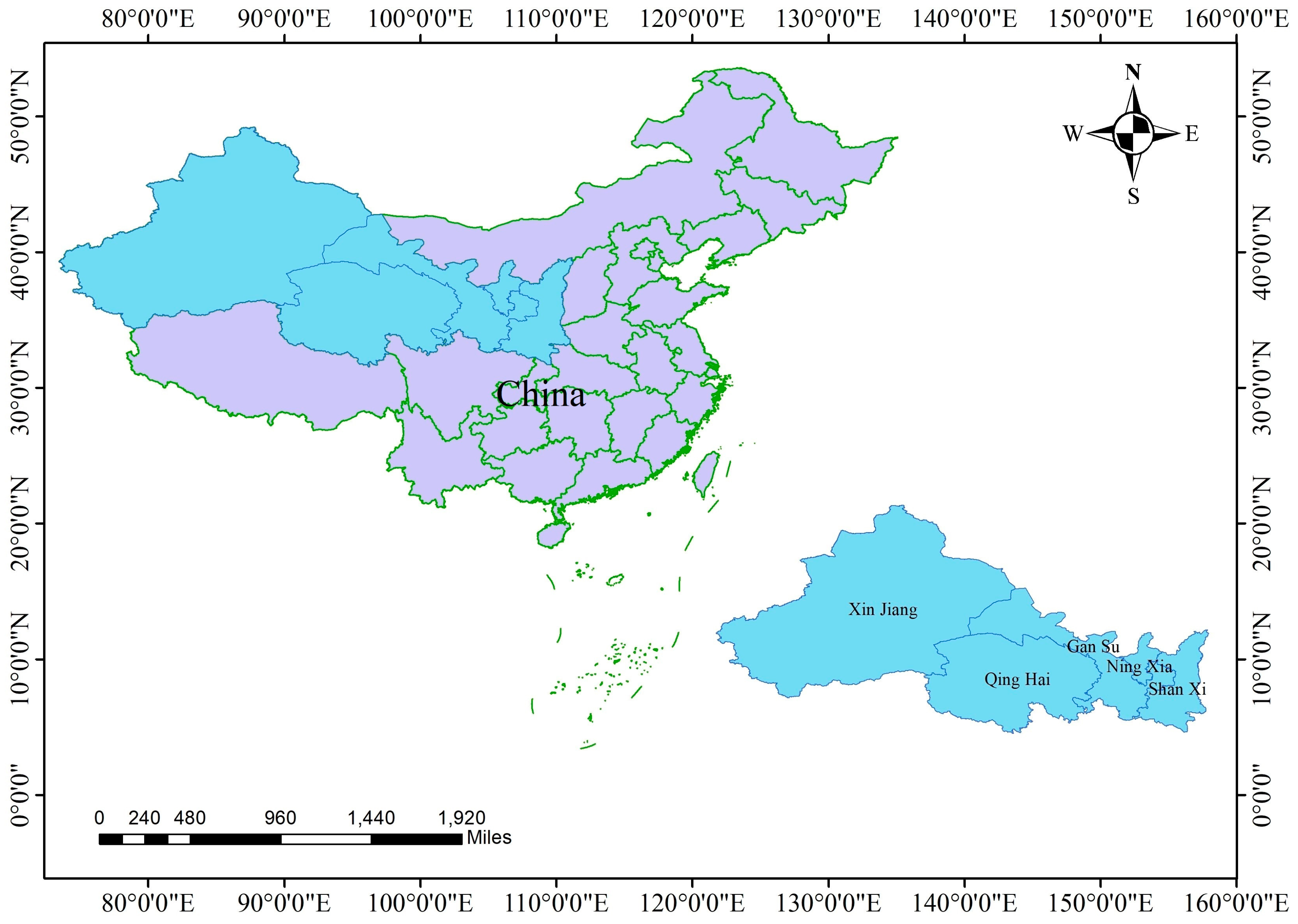
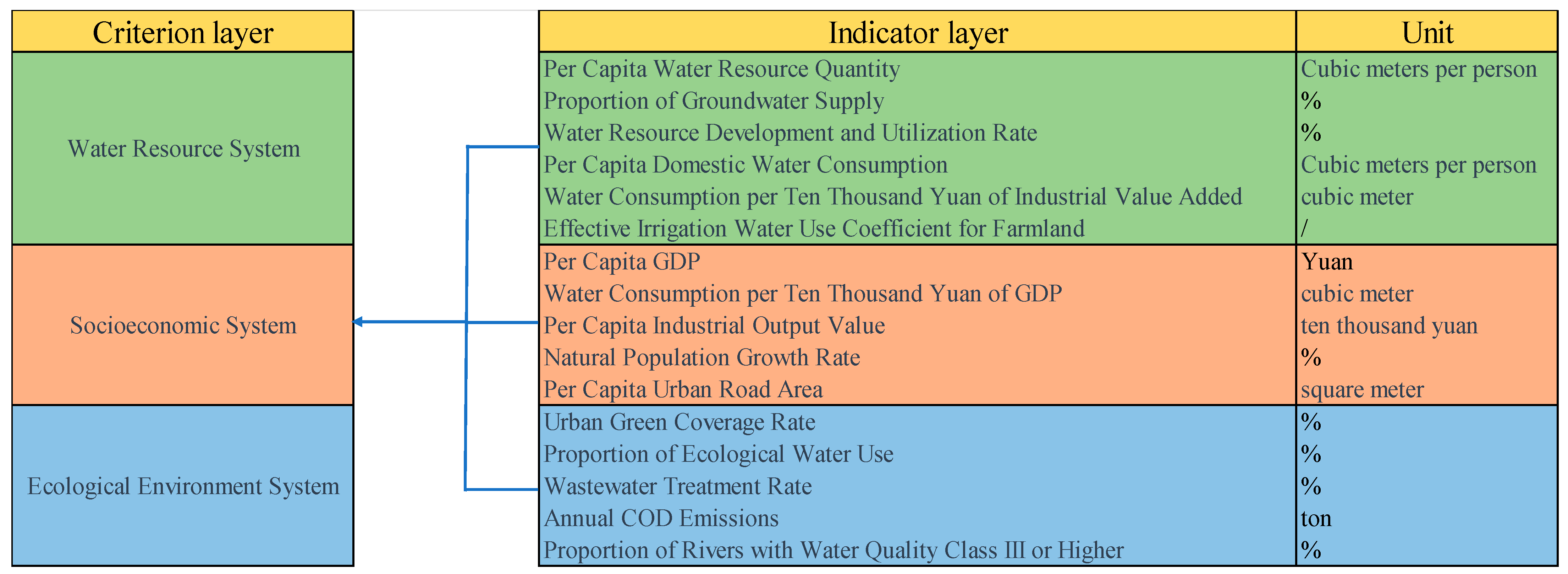

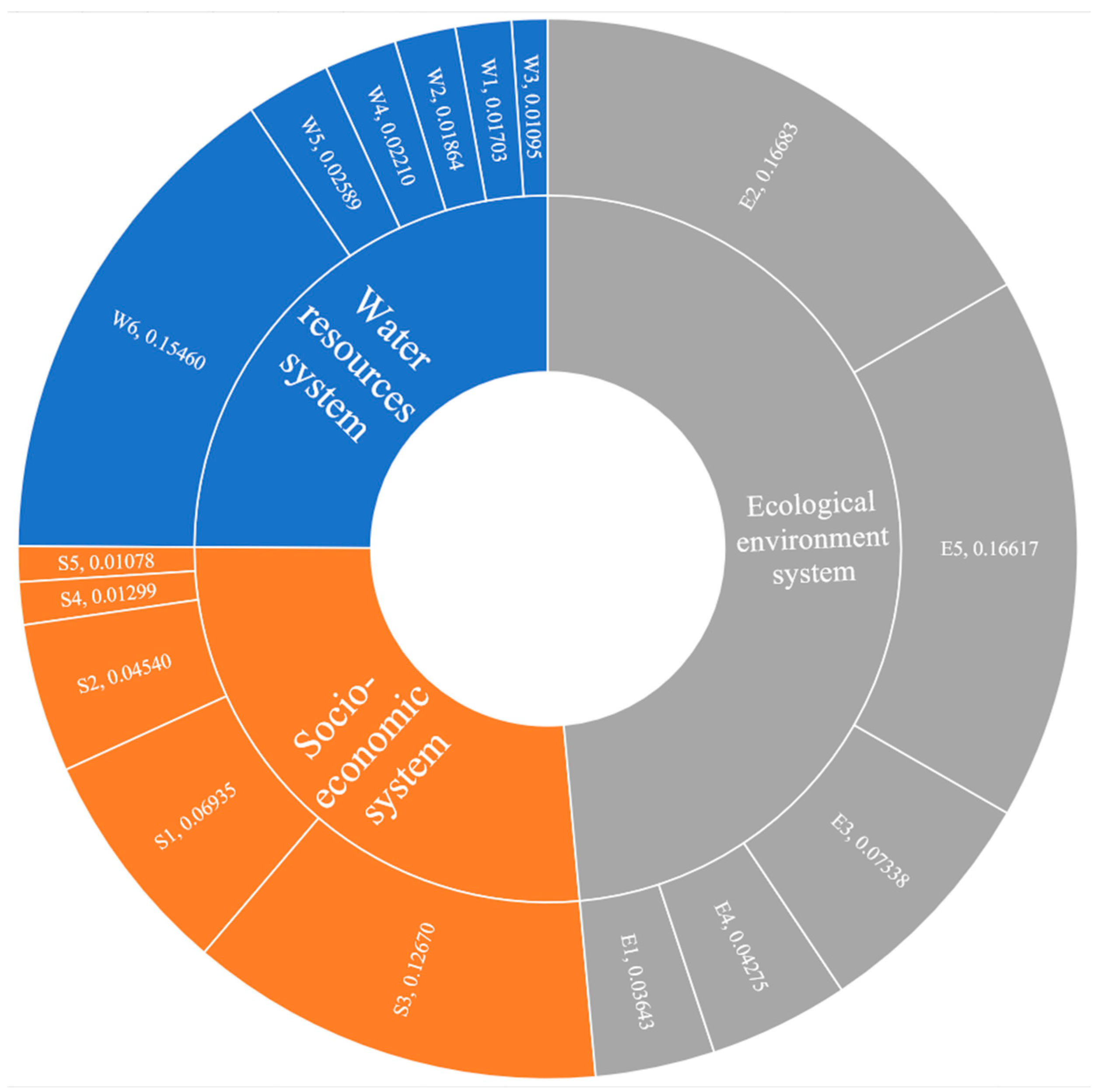

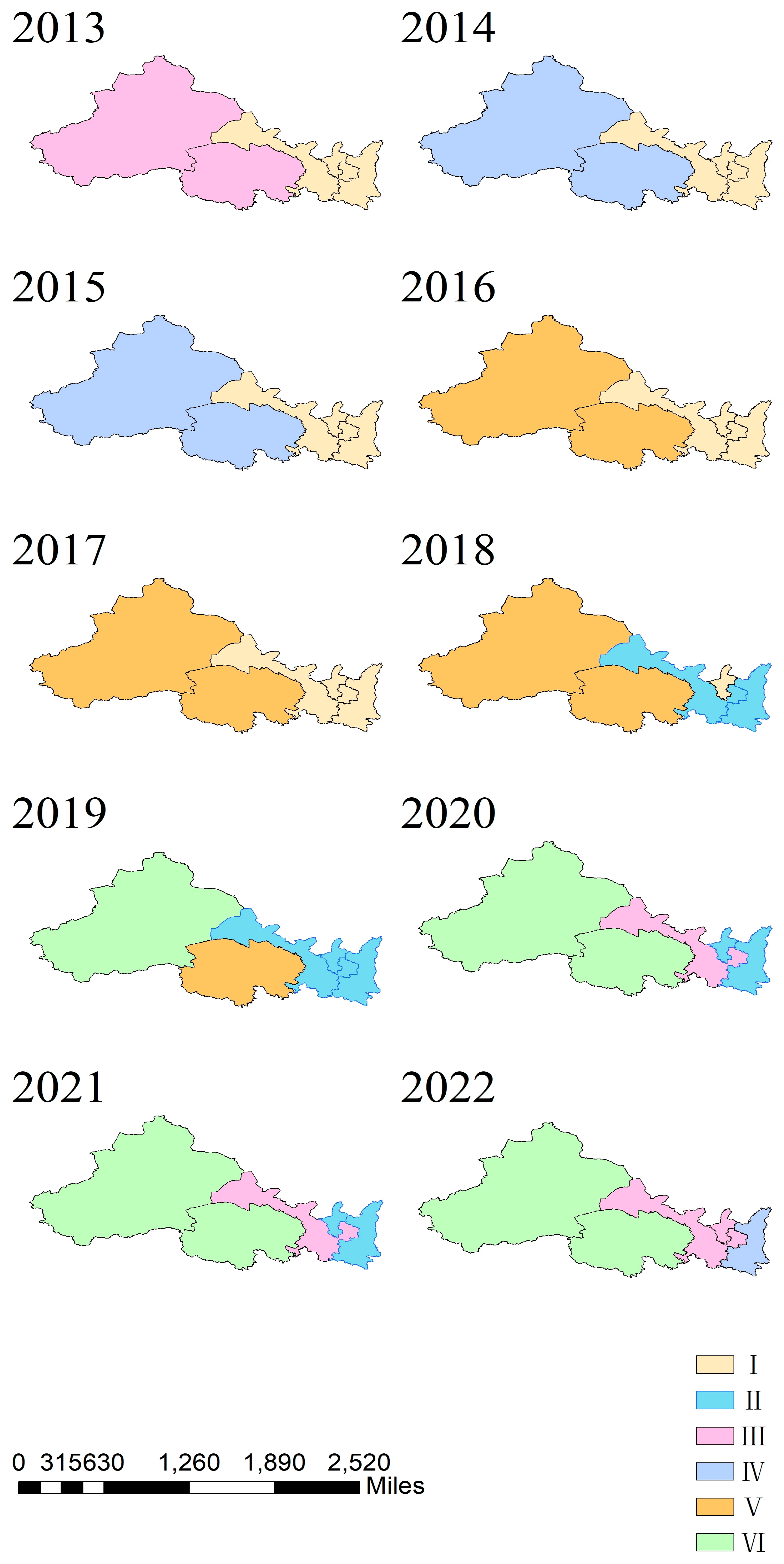
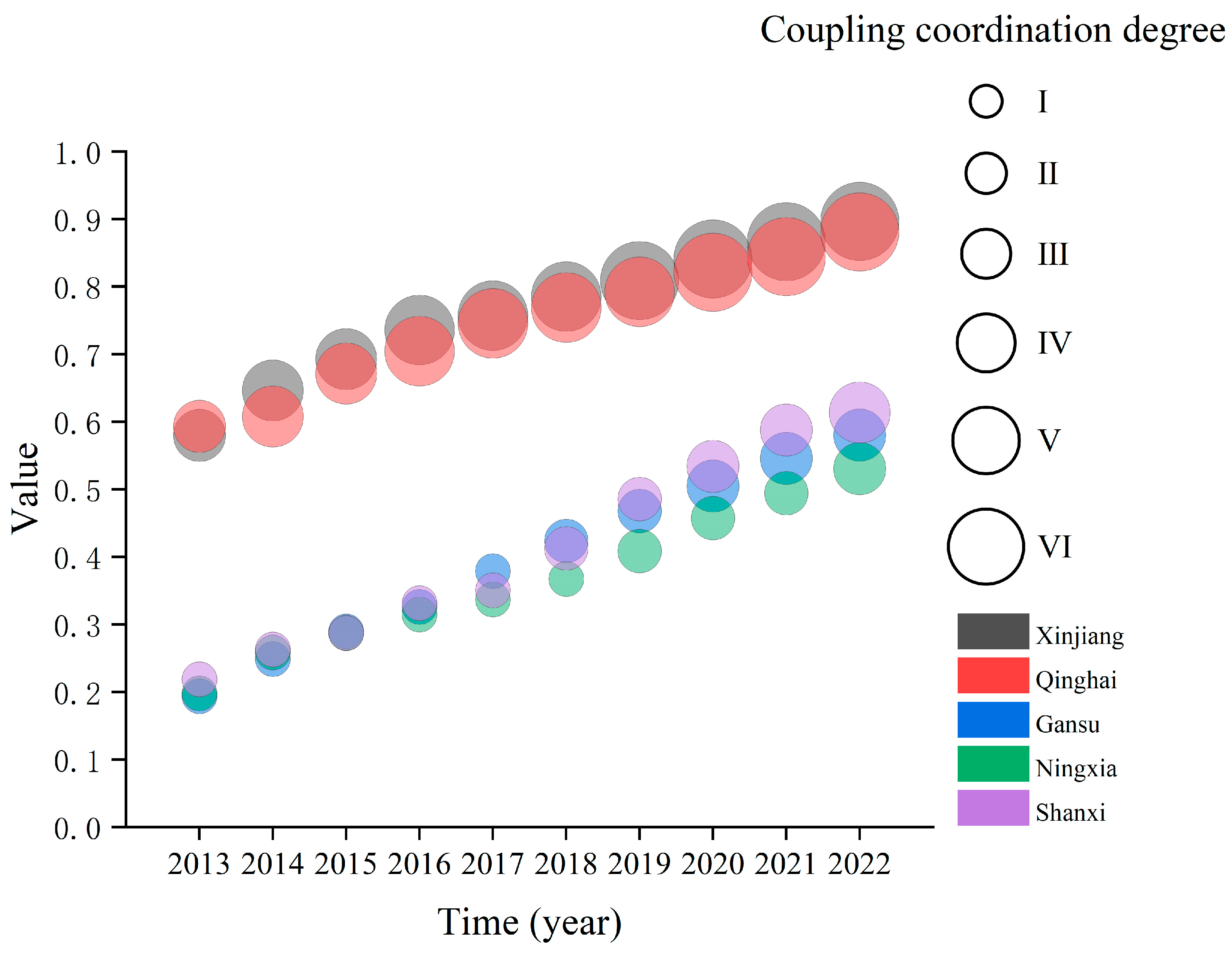
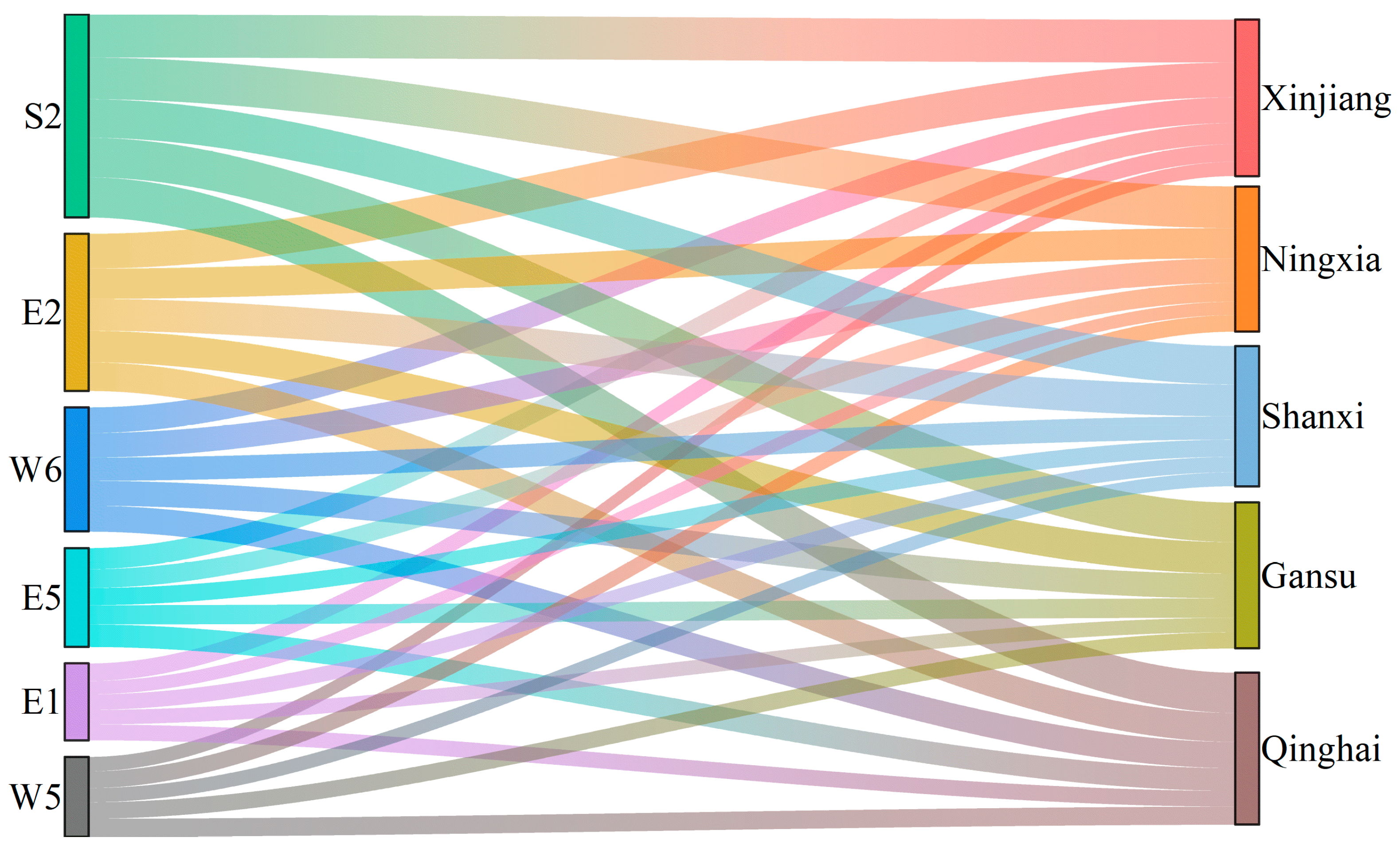
Disclaimer/Publisher’s Note: The statements, opinions and data contained in all publications are solely those of the individual author(s) and contributor(s) and not of MDPI and/or the editor(s). MDPI and/or the editor(s) disclaim responsibility for any injury to people or property resulting from any ideas, methods, instructions or products referred to in the content. |
© 2023 by the authors. Licensee MDPI, Basel, Switzerland. This article is an open access article distributed under the terms and conditions of the Creative Commons Attribution (CC BY) license (https://creativecommons.org/licenses/by/4.0/).
Share and Cite
Shi, J.; Yang, H.; Wang, F.; Sun, D.; Run, Y. Comprehensive Evaluation and Coupled Coordinated Development Study of Water–Economic–Ecological Systems in the Five Northwestern Provinces of China. Water 2023, 15, 4260. https://doi.org/10.3390/w15244260
Shi J, Yang H, Wang F, Sun D, Run Y. Comprehensive Evaluation and Coupled Coordinated Development Study of Water–Economic–Ecological Systems in the Five Northwestern Provinces of China. Water. 2023; 15(24):4260. https://doi.org/10.3390/w15244260
Chicago/Turabian StyleShi, Jiahao, Huan Yang, Fuqiang Wang, Di Sun, and Yushan Run. 2023. "Comprehensive Evaluation and Coupled Coordinated Development Study of Water–Economic–Ecological Systems in the Five Northwestern Provinces of China" Water 15, no. 24: 4260. https://doi.org/10.3390/w15244260
APA StyleShi, J., Yang, H., Wang, F., Sun, D., & Run, Y. (2023). Comprehensive Evaluation and Coupled Coordinated Development Study of Water–Economic–Ecological Systems in the Five Northwestern Provinces of China. Water, 15(24), 4260. https://doi.org/10.3390/w15244260






